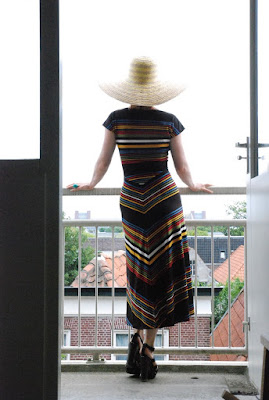Well, I decided it was that time again. This time, I was going for something fairly simple: the nejiri or twist. A design which appears both in Pattern Magic 1 and in Pattern Magic - Stretch Fabrics, all be it with some differences.
I made a nejiri top based on the instructions in the first book way back in 2011. I didn't even blog about it but I did put it on Burdastyle. This is the picture I showed there. I don't have it anymore. The fabric got a bit worn out and I remember finding it annoying that I had to keep adjusting to the top to keep that twist in place. This is something which is hinted at in the book. And in the third book, there is a version of this top in which the issue is addressed: The twisted top with stopper.
This one.
There are some differences in the drafting instructions (like the amount of horizontal shift and whether or not the armholes get shifted too) but the twist principle is basically exactly the same. The top itself is not quite the same. In the older instructions, the twist is added to a basic sloper (without waist darts, but still), in the newer book, the top itself has straight sides and would, without the twist be loose-fitting.
I decided to try out the new version as described.
This also gave me a good opportunity to investigate something I have wondered about for a long time: Are the shifts on the front and back pattern pieces the same or mirrored?
When I made my original top, I followed the instructions given in the book to cut the whole top as one big pattern piece. This meant both front and back curved in the same direction. Later, I saw a blog post by someone else who had made this top but seemed to have mirrored the pieces.
Now, it was time to try out. Luckily, I had enough fabric to cut three body pieces and those stoppers (which are just bands of fabric).
These are the pictures of the top with the same pattern piece used for front and back (my apologies for the lighting issues in all the following pictures. I was in a bit of a hurry and didn't check them properly).
Laid flat, it looks like this:
Do you see the way the seam curves to the front?
And this is the result with a mirrored piece for the back. I somehow thought it might provide more relaxed twisting but I think it may be a bit too relaxed...
It was really hard to get the top on the dummy in such a way that the armholes were more or less at the same level while there is no real twisting at the waist.
Flat on the table, this one looks quite interesting:This shape might work better in a more fitted garment but I think my test here proves I did understand the instructions all along. The nejiri top can be a bit fussy to wear, but I did make it the way the book intended and I will do that again.
Now, I just have to put on those stoppers!
















































